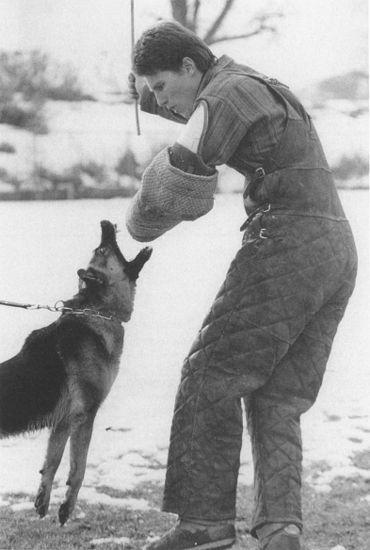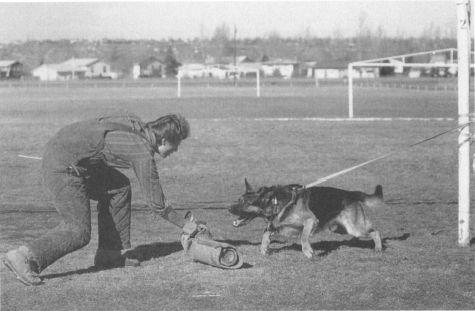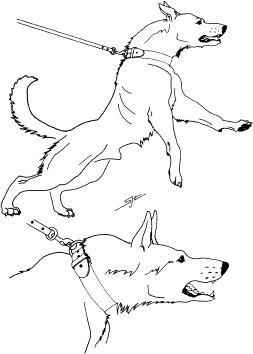An Overview of the Protection Phase
The Protection phase of Schutzhund work has raised more eyebrows than any other aspect of the sport. Some people consider it cruel and savage. Others say that it is too dangerous. Still others believe that protection training somehow returns the dog to a wild state. Despite these misapprehensions and the criticism that arises from them, we consider protection to be the most exciting of the three phases of training. It is also at the core of the purpose of Schutzhund sport–to test, select and promote dogs of character and working ability.
These myths and misconceptions surrounding Schutzhund bite work still persist and must be refuted. One frequently voiced concern regarding protection is that the training will alter the dog’s temperament. However, experience has shown that a dog that is confident and friendly before protection training will remain confident and friendly after protection training. We do not brainwash the animal in any way. We merely strengthen and mold a perfectly natural facet of its behavior that we can already see in some form or degree in the dog before it is ever exposed to agitation.
Another myth surrounding Schutzhund bite work is that the training involves cruelty to the dog. Nothing could be further from the truth. After all, the primary objective in bite work is to build and maintain confidence, and this state of being cannot be evoked by cruelty or by force. Confidence and self‑assurance evolve instead as a result of a carefully designed series of exercises that teach the dog, first, to display aggression in appropriate circumstances and, second, that it can always expect success in so doing. The dog must develop the self‑assurance necessary to oppose a human willingly, with conviction and with force. This it will not do if abused or mishandled.

The protection phase of Schutzhund has raised more eyebrows and more controversy than any other aspect of the sport. (Stewart Hilliard and Chuck Cadillac’s “Gitte.”)
The use of the reed stick during Schutzhund protection routines caused much criticism and concern during the early years of Schutzhund in the United States. However, for a number of reasons, the stick hits are not dangerous for the dogs nor even particularly unpleasant. Stick hits are carefully and precisely administered by an agitator who is expert at his craft, and the blows fall to one side or the other of the dog’s spine, on the thick dorsal muscles of the back. Because the stick is very light and flexible, the dog is covered with fur and the agitator is skilled and experienced, no harm comes to the animal. Although the stick hits, characterized by sharp, menacing gestures, reflect a threat to the dog that it must withstand in order to pass a Schutzhund examination, they inflict at most a brief sting.
Indeed, the animal shows us clearly whether this pain is important to it, for it has the choice to undergo the stick hits or not. If the dog finds the blows truly unpleasant, if it is frightened by them, then it will bite badly or not at all while under the stick. Consequently, because it does its trainer no credit, the dog will be retired from Schutzhund and it will never see the stick again. If, on the other hand (like a football player who repeatedly endures far worse than a brief sting for his love of the game), the dog is so transported by the passion and excitement of bite work that it is oblivious of the blows, then we can unmistakably see that the dog has made its choice to go eagerly under the stick. We therefore admire the dog and use it for precisely this quality in it. The issue of the stick hits illustrates most clearly the central dynamic of Schutzhund sport: The Schutzhund dog loves the game.
A final misconception involves the common conviction held by many dog owners that their dogs will, without benefit of training or experience, protect them in a dangerous, real‑life situation. This is extremely unlikely. Most family dogs are systematically discouraged from behaving aggressively under any circumstances. In addition, the majority of dogs simply do not possess the necessary courage to bite when suddenly threatened. Their immediate and quite reasonable response is to retreat from an ominous situation with which they have not had any previous experience. The fact that a dog barks aggressively from behind the safety of a fence or a door is no indication that it will protect its owner when push comes to shove. Even in the case of a dog of unusual quality, a great deal of schooling is necessary to overcome the dog’s ultimate inhibition against biting and to develop its confidence and expertise in protection.
In fact, it is extraordinarily difficult to induce a dog to bite a human for real, and as trainers we spend an inordinate amount of time and energy striving to overcome this problem. Many dogs are willing to threaten, harass and even nip when they have someone on the run or when they confront a person who is not particularly dangerous. However, this is not the sort of person against whom we need protection. For a dog to enter into close combat with a person who is unafraid and genuinely means to hurt somebody is a different matter altogether.
Remember, biting is an extreme act. The animal in question must be either extremely frightened or extremely brave.
In an emergency, it is best if the dog is not only brave but also well trained, and a dog that has proven its courage and steadiness on the Schutzhund field and that is then schooled in personal protection can provide many years of service as a reliable family guardian.
Despite the advantages of owning and training a well‑schooled Schutzhund protection dog, there can also be decided disadvantages. Training a dog to a high level of competence in bite work is a long and arduous process. To begin training and then not follow through to this level of competence is to invite problems. A dog that is not fully trained has neither the control nor the judgment necessary to make a good decision, and a mistake of judgment with such a powerful animal can result in injury to an innocent party and a possible law suit.
In perfect truth, whether well trained or not, dogs simply do not possess the capacity to safely and reliably judge when and whom they should bite, and when not. Therefore, the responsibility for this judgment rests entirely in the hands of the owner. It is up to him to constantly and accurately predict his dog’s reactions in daily situations and to restrain the animal if there is a possibility that the animal will behave aggressively when in reality there is no danger.
For this reason, the person who is considering Schutzhund must be reflective regarding his own needs and competencies. His attitude toward the dog must be one of respect for a powerful weapon. The owner must have the determination and the ability to make good decisions regarding the safety of his dog and of other people.
It should be evident that, contrary to the lurid image bite work conjures up in the imaginations of the uninformed, training is carried out gradually and in a humane manner.
The process of building the dog’s confidence and developing its instincts is called agitation, and it is an art. The person who performs this work is called the decoy, the agitator or the helper , and his function is to serve as the dog’s adversary in order to progressively develop the animal’s desire to bite and to increase its courage. The agitator must be an athlete, physically strong and agile, but more importantly he must also be a person with what we call “feeling”–an accurate intuition for what makes dogs behave the way they do. The agitator must have the ability to observe a dog for a moment and then know what is in its heart. An expert agitator makes a good dog better. A mediocre agitator can make even a good dog look mediocre. A poor agitator can ruin a dog.
Throughout the protection section of this book we use the terms agitator , decoy and helper interchangeably. We prefer the term agitator because it best describes what the person actually does. However, we also use helper because this has become, for the sake of public relations, the officially accepted title (“help” has a more innocuous connotation than “agitate”). We include decoy because this term is commonly used on the training field in many parts of the country.

Early German service dog trials. Two exercises that no longer play a part in Schutzhund: the attack under gunfire (top) and guarding an object (bottom). (From von Stephanitz, The German Shepherd Dog, 1923.)
In addition to a competent handler and a gifted agitator, a Schutzhund team requires the right dog. The dog must have certain qualities of character. It is easy to imagine that the most aggressive, nasty, suspicious, hyperexcitable animal possible would be a good candidate, but this impression is totally incorrect. Rather than suspicious (a trait founded upon unsureness), the Schutzhund dog must be strong in character–steady, friendly, reliable and confident. The dog must be rational, in the sense that it must be capable of distinguishing between real threats and the normal, sometimes chaotic events that surround it. Thus, the single indispensable character trait of a working dog is stability. The animal must be steady, neither timid nor inappropriately aggressive. It may be friendly or it may not, but above all it must not be unreliable or dangerous.
The animal that snarls at a person approaching it, or tucks its tail and anxiously growls in a group of people, is not representative of the Schutzhund dog, both because it is not safe or reliable and also because it does not express the necessary power. It is from steadiness and neutrality–and the courage they bespeak–that the dog’s ultimate power in bite work arises. Contrary to common belief, the Schutzhund dog is not filled with suspicion or hate for the agitator. It does not bite from rage, fear or malevolence. It does it because the activity fulfills a great number of its instinctual needs. Quite simply, the Schutzhund dog bites because it likes biting.
The animal’s nature is that of a hunter, a predator, a fundamentally aggressive animal. Its urges to chase, bite and struggle are part and parcel of its life instincts. Just as it finds pleasure in eating and mating, so it also gains intense gratification from biting.
This point must be absolutely clear: We do not teach the Schutzhund dog to bite. Biting is not an artificial or contrived behavior, like wearing clothes or riding a bicycle are for a circus bear. As Schutzhund trainers we merely take a behavior that is already native to the dog and we channel it, strengthen it and mold it to suit our purposes. Therefore, it should be evident that we can only train the dog if it wants to bite. If it does not, then nothing remains but to find a new dog.
In Schutzhund protection the dog is a voluntary, even an intensely eager participant.
CANINE AGGRESSION
The basic requirement of Schutzhund protection is the bite itself–the dog’s grip upon the sleeve. The power and quality of the bite are important not only from the standpoint of getting the job done (that is, stopping and disabling an aggressor). They are also important because how the dog bites provides an index to its quality as a working dog and as a prospect for breeding.
The ideal bite is what we call full, so that the dog grips the sleeve with its entire jaw, including the molar region. The dog need not fight this way in order to fight a human effectively. But working dog trainers have found over many years that dogs that bite full are normally the best and the bravest animals.
What makes the difference between the dog that bites full and the dog that does not is, to a great extent, their differing degrees of courage. But it is also a fact that the two animals are motivated to bite for different reasons, by different types of behavior. Their characters are different.
The dog that bites full displays at least a certain degree of prey drive. It pursues and bites the decoy for the same reason that it would chase and bite a rabbit. It is “hunting.” The dog in prey mood is unafraid. It bites quietly, its eyes are tranquil and its expression, although intensely keen, is neutral. This dog does not snarl or grimace or flinch as it bites. It enjoys itself and, most important, it will pursue. For the opportunity to bite it will run hundreds of yards or even search for extended periods of time.
The animal that bites with only half of its mouth, or with just its canine teeth, shows a different kind of behavior, a different urge that we call defense drive. This dog bites not because it is fun for it, but because it feels it must. It is stressed. It feels endangered, and to at least some extent afraid, and it bites primarily to defend itself. It is therefore much less keen to pursue a person or search in order to find him and engage him in combat. In addition to biting with just the front of its mouth, the defense dog also tends to chew, or nervously shift his grip, especially when under pressure. This dog bites violently and with malevolence. The defense dog is also noisy while it bites, growling and snarling, and it often bristles, erecting the hair on the withers, back and rump.
Almost every animal has the capacity (to some extent) to express both prey‑ and defense‑motivated aggression. Because each type of behavior has its advantages, during agitation we make use of them both.
Prey brings with it eagerness and pleasure in biting. But a “pure” prey dog lacks intensity. In addition, it is also woefully unprepared to bite in a real‑life “street” situation in which it is called upon to protect itself and its owner from harm. Remember , a Schutzhund dog should also be a civil protection dog. During agitation, the prey dog is taught to regard the protective sleeve that the agitator wears as prey, like a rabbit or some other animal that the dog would naturally chase down and bite. It will happily bite anyone that wears the sleeve, even its handler. Consequently, when faced with a person who means to do it or its owner harm, and who wears no sleeve and does not follow the rules of agitation, it is very much at a loss.
The defense dog, on the other hand, is what we call sharp –it is always ready to fight, and fight in earnest, in threatening or disorienting circumstances. It is “strong‑civil,” meaning that it is less interested in the sleeve than the prey dog and more eager to close with the agitator himself. Defense brings with it intensity and violence, and the power to fight in a deadly situation.
However, defense also brings with it stress. The fact that the animal behaves defensively implies that it feels endangered, that fear is at the root of its actions. Consequently, the pure defense dog leaves many things to be desired. For example, it does not bite with a full mouth on the sleeve, and it is frequently too overstimulated during agitation to learn well.
In training, we strive to make the protection dog a balanced animal that expresses both prey‑ and defense‑motivated behavior. However, although with intelligent work we can change the dog’s basic orientation to some extent, its basic prey‑versus‑defense characteristics are mainly a product of genetics. The animal comes to us primarily prey‑oriented or primarily defense‑oriented. Therefore, as trainers and sportspeople, it is important to choose the type of dog with advantages and disadvantages that suit us best.

Prey behavior. As the helper reaches to steal the grounded sleeve–the dog’s prey–the animal orients at the sleeve itself rather than at the person. The dog’s facial expression is neutral, reflecting only keenness and strength of effort to reach the prey.

Defense behavior. Now the helper attacks the dog. The animal focuses on the attacker rather than the sleeve, and the change in the dog’s expression is dramatic.

In prey mood the dog does not threaten, seeking only to reach the prey and bite.

In defense mood, the dog threatens.
The authors prefer an animal that is fundamentally a prey dog. It bites for fun, day after day, clearheaded and happy, but there is a deadly serious edge of defense to it that lends it intensity. Prey will give it pleasure in biting and durability over years of competition and training, while defense will give it the raw power and violence we can call on in time of need.
Дата добавления: 2015-12-08; просмотров: 955;
